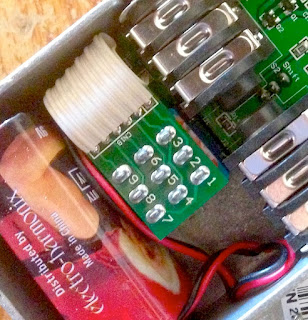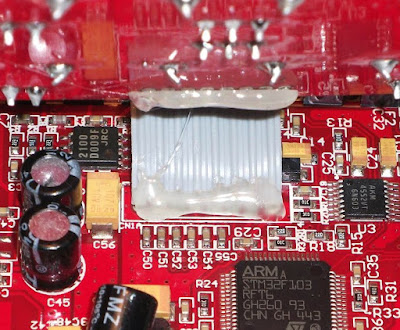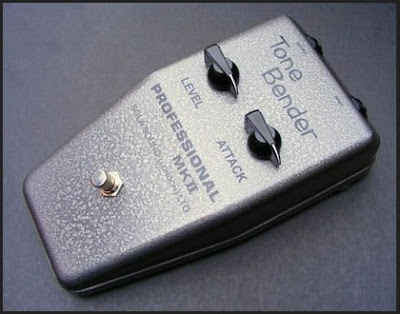Fuzz is one of the most emblematic guitar effects. Satisfaction (The Rolling Stones), Purple Haze (Jimi Hendrix), Think For Yourself (The Beatles)... The number of great songs incorporating this effect are countless, and have progressively transformed the Fuzz effect into a reference in the electric guitar world!
Today, we can find a lot of different fuzz, with multiple variations around the same circuit... In order not to be lost in this mess, I wrote a small overview summarizing the different types of fuzz that you can find. Of course, it is not an exhaustive listing, I tried to recapitulate the main fuzz, and modern and "boutique" variations that can be found today... Make your choice!
1. Gibson Maestro FZ-1 (1962)
This is the first fuzz ever invented! Originally, it was intended to imitate brass! To give you an idea of how it sound, it the fuzz used on "
Satisfaction" of the Rolling Stones.
It has a nasty, sax-like sound, quite aggressive in the treble range. It is a harsh, dirty sound that can feel almost like a ring modulator in last strings! It is a very peculiar sound, very "vintage-sounding" (well, of course, it is from 62!). To be honest, I do not really like it, but I think it can be used a bit in some styles like garage rock or psychedelic rock.
Of course,
the original pedal is extremely rare and expensive... (
I had one to repair recently!) The Boss FZ5 emulate with a numeric algorithm the Maestro fuzz, and clones are pretty rare (you can find clones in small boutique companies), because of the weird sound that makes it a bit special... Gibson did a reissue at some point, but it was also quite expensive, and had the downsides of the original pedal (size, no power supply input...etc).
2. Sola Sound Tonebender Mk1, Mk1.5 and Mk2 (1965 et 66)
Created in England in 1966 to compete the Gibson Maestro (which was too expensive to import...), this fuzz quickly became a reference. The MK2 version was used by many english rock musicians in the 60s, like Jeff Beck or Jimmy Page for instance. It has been also been copied by many brands: Marshall Supafuzz, Vox Tonebender are examples of fuzz "heavily inspired" by the Tonebender.
It has a more
classic fuzz sound, loud and powerful, with quite a lot of saturation. The saturation can be modified with the volume knob of the guitar, like with Fuzz Faces. The sound is warmer, softer than the aggressive Maestro sound, with quite a lot of mids. Basically, it sounds a bit like a Fuzz Face, but with more saturation and a bit more aggressive, close sometimes to a distortion.
It has been clone, modified and reproduced by many builders: D*A*M (who makes incredible replicas), Earthquaker Devices Tone Reaper, Fulltone Soul Bender, Basic Audio Scarab Deluxe, JHS Bun Runner, Ramble FX Twin Bender...etc.
3. Fuzz Face (1966)
This THE Fuzz, the most emblematic fuzz effects with its famous round and red face (well, gray at the beginning).
Used by Jimi Hendrix, it became rapidly famous! Conceived in 1966 by Dallas Arbiter in England, it used germanium transistors at first, which were later replaced with silicon transistors, more stable. Read my
article about the fuzz face circuit here.
The sound of this fuzz is characteristic:
very soft, warm and round, it has a very "creamy overdrive" feeling that evokes almost always (especially if you have a Stratocaster-type guitar) the sound of Hendrix. It also responds very well to the guitar volume knob: by turning down this knob, you can go back to an almost clean sound! Versions with germanium transistors are ideal for this, but are less stable (sensitive to temperature, demanding about the transistors characteristics). It is less saturated than a Tonebender. This is really a classic fuzz, easy to use and very good sounding
The Fuzz Face is still produced by Dunlop (with a lot of versions: mini versions, germanium and silicon versions...etc.), but many builders took the opportunity to build their own Fuzz Face version and make original versions: Analogman Sunface (a great replica of the vintage Fuzz Faces), that I cloned here and here, Fulltone 69, JHS Pollinator, Boss FZ3, Chase Tone Red Stardust... are all modified Fuzz Faces.
4. Roger Mayer Octavia (1967)
With its strange spaceship shape, the Roger Mayer's Octavia will not leave you indifferent. Roger Mayer was Jimi Hendrix's guitar tech (...yep!), and has created and modify pedals for the master... The Octavia is one of them.
One of the things that make this pedal unique (beyond its weird look), is the fact that
it produces an upper octave sound above what you play! This octave effect is more pronounced around the 12th fret, so it is more hear-able during solos. It has quite an aggressive sound, which can be slightly dissonant (because the octave is never perfet in terms of pitch). Here again, some Hendrix's song are
representative of the sound of this pedal, as the solo Purple Haze or Fire.
Roger Mayer is still producing the pedal, but it also has been cloned and modified: Fulltone Octafuzz, Catalinbread Octapussy (I love this name), Electro Harmonix Octavix...etc. Which seems to please Roger Mayer a lot, as he put on his website this beautiful quote: "Those who can invent do, those who can't invent copy" (Angry Roger is angry, but well, it is understandable)
5. Univox Super Fuzz (1968)
Well, this is a personal favourite, for me this fuzz is the evillest fuzz of all, a monster in a pedal enclosure, a true Pandora box! This fuzz, invented in 1968 by the Japanese company Shin Ei (which became Univox later), has not only a killer look (well, from the second version in 1970), but is also the most violent an loudest fuzz ever!
It has been used by Pete Townshend during the Who's live performances, and has been re-discovered in the 90s by many stoner rock bands, some of which used it almost on every song like Fu Manchu!
Like I said, this Fuzz has an over saturated heavy sound. There is a lower octave that is added to your tone and make it heavier, and an upper octave, quieter than on the Octavia, that is hear-able around the 12th fret. To give you an idea of the
apocalyptical sound of this pedal, listen to any song of Fu Manchu. (check
Cyclone Launch for instance)
Unfortunately, the production of this wonderful pedal was stopped. Boss produced a clone in 1993,
the Boss Hyper Fuzz FZ2, which had some success in the stoner rock / doom circle, but is not produced any more. Today, Behringer produces a cheap clone, and some boutique builders make clones (Wattson Super Fuzz (replica of the 68 version), Solid Gold FX Formula 76). Producing a fuzz respecting the spirit of the original Super Fuzz (sound and look) is one of my current projects. If you're interested, please email me for details.
6. Electro Harmonix Big Muff Pi (1969)
This is an absolute classic created in 1969 by Electro Harmonix: the Big Muff Pi. This pedal is still produced, an had many different versions (Deluxe, Russian, Triangle, Ram's Head...). It has been used by a lot of different artists because of the sound it has, and especially the almost infinite sustain it gives to your tone. David Gilmour (Pink Floyd) is a well known
afficionado of the Big Muff.
Comfortably Numb's solo is a good example of what kind of sound can be expected from a Big Muff.
It is a heavy, saturated sound, but still compressed and smooth, that gives a nearly infinite sustain and crazy harmonics. The tone potentiometer allows to go from a trebly aggressive fuzz to something warmer and bassy. One of the characteristics (and weaknesses) of this fuzz is the lack of mediums that the EQ create. You can disappear in a mix because of that. To avoid this, David Gilmour was using it with an overdrive that was bringing more mids, and today, there are versions of the Big Muff with a different tonestack that have been created to avoid this. If you are interested, I wrote an
article about the Big Muff circuit.
This pedal is the clone's queen, probably the most cloned pedal ever! There are hundreds of versions of the Big Muff, as it is a very well documented circuit, and very tolerant to modifications. Pete Cornish G2, P1 and P2, Skreddy Mayo, Way Huge Swollen Pickle, Mojo Hand FX Colossus and Iron Bell, Blackout Effectors Musket, Black Arts Tonework Pharaoh...Etc Each "boutique" builder has its own version of the Big Muff, and I already made a few
Ram's Head Big Muff myself!
7. Shin Ei companion Fuzz (1970)
Lets finish this list with an original rarity, the Companion Fuzz, created in 1970 by Shin Ei (again).
If I put this pedal in this overview, it is that despite its rarity, it really has a very special, unique sound!
It produces a "chainsaw", buzzy, nasty sound!
It has a very harsh and raspy sound that is really recognizable. This pedal has been used by some psychedelic rock bands, and more recently by Dan Auerbach from the Black Keys for the dirty sound that it makes... It is really an unique sound, either you like it or you hate it!
Due to this weird sound, demand is quite low for this kind of effect, and re-editions or clones are quite rare. The original is of course not produced any more (and reaches crazy prices on ebay), but Earthquaker Devices recently issued a clone: the Terminal Fuzz. Some small boutique builder still make clones of it.
8. 1970-2010: what happened?
Where did all the innovations of the fuzz pedal go during this period? The 70s marked the beginning of overdrives, that gradually replaced fuzz, both in music and guitarist's gear. Fuzz was replaced with amp and overdrive saturations. Indeed, since the beginning of the 70s, amplifiers (finally!) have a master volume, and fuzz are no longer necessary to have a distorted sound. New musical genres that emerged at this time, like hard rock, are more into heavy saturation from the amplifier than the "weird" saturation of fuzz.
However, in some genres played irreducible musicians,
fuzz still holds out against overdrive and distortion invaders. Stoner rock guitarists rehabilitate fuzz effect to produce heavy saturated sounds (Kyuss, Queens of the Stone Age, Fu Manchu...). Some indie bands make fuzz become their sound trademark (Smashing Pumpkins, shoegaze players...). During the 2000s, with the arrival of bands inspired by the 60s (like the White Stripes and others garage rock bands), fuzz resurrects and becomes a classic effect again. Other artists use it in a new way to create new musical landscapes, and make it popular again (like Matthew Bellamy and his Fuzz Factory)
Traditional and boutique manufacturers modify and enhance vintage fuzz by making them easier to use (9V power supply input, smaller size), less noisy and more stable.
Some builders innovate and create entirely new circuits, most of the times completely crazy: Death by Audio (with the Fuzz War for instance), Devi Ever (Hyperion, Soda Meiser) or Zvex with the Fuzz Factory. Others invent new designs with more classical sounds: Wampler Velvet Fuzz or D*A*M Meathead for instance!
Personally,
I am a huge fan of fuzz. The Super Fuzz, the Big Muff and the Fuzz Face are must-try pedals for me. Moreover,
fuzz are simple pedals that are easy and fun to make, and that can easily be modified and customized! I really advise you to try to make one... The Big Muff is the perfect pedal to begin with (with a PCB if possible), even for a beginner, and can be modded really simply (the circuit is very tolerant to modifications).
Here it is ! I hope that this article gave you a good overview of the different fuzz that exists, so you can choose the one you like the most! Do not forget that this is not an exhaustive list, and that many other fuzz exist... The quest for the ultimate fuzz is nearly infinite (gotta catch them all!)
Do you have any question? Post a comment!
You like this article? Thank me by liking the
Coda Effects Facebook Page.
To go further:
"Fuzz timeline" from the Big Muff page
Another
Fuzz timeline by Hewitt's garage
Fuzz Face history : a nice video about Fuzz Face history.
Maestro Fuzztone history: great article from vintageguitar.com
History of Tonebenders by D*A*M
























